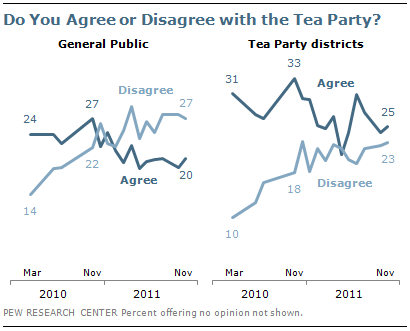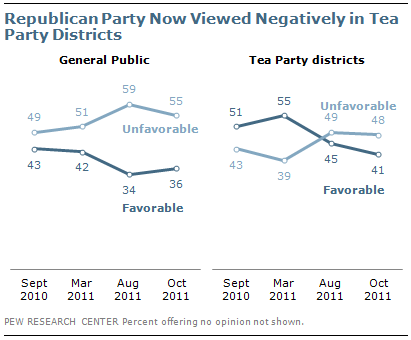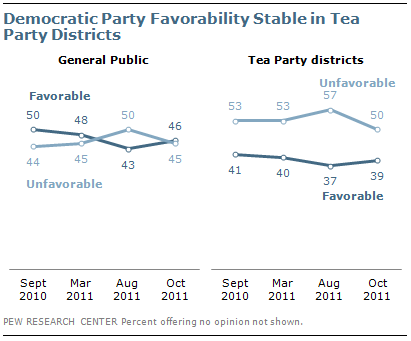Since the 2010 midterm elections, the Tea Party has not only lost support nationwide, but also in the congressional districts represented by members of the House Tea Party Caucus. And this year, the image of the Republican Party has declined even more sharply in these GOP-controlled districts than across the country at large.

In the latest Pew Research Center survey, conducted Nov. 9-14, more Americans say they disagree (27%) than agree (20%) with the Tea Party movement. A year ago, in the wake of the sweeping GOP gains in the midterm elections, the balance of opinion was just the opposite: 27% agreed and 22% disagreed with the Tea Party. At both points, more than half offered no opinion.
Throughout the 2010 election cycle, agreement with the Tea Party far outweighed disagreement in the 60 House districts represented by members of the Congressional Tea Party Caucus. But as is the case nationwide, support has decreased significantly over the past year; now about as many people living in Tea Party districts disagree (23%) as agree (25%) with the Tea Party.
GOP Loses Favorability Advantage in Tea Party Districts

The Republican Party’s image also has declined substantially among people who live in Tea Party districts. Currently, 41% say they have a favorable opinion of the GOP, while 48% say they have an unfavorable view. As recently as March of this year, GOP favorability was 14 points higher (55%) in these districts, with just 39% offering an unfavorable opinion
Among the public, 36% now say they have a favorable opinion of the Republican Party, down from 42% in March.

By comparison, opinions of the Democratic Party have shifted less – from 50% favorable last summer to 48% in March and 46% in October. The party’s image has remained in negative territory among those living in Tea Party districts throughout this period– currently about four-in-ten (39%) say they have a favorable view of the Democratic Party, while 50% offer an unfavorable view.
But the steep decline in GOP favorability in Tea Party districts means that these constituencies now view the Republican Party about as negatively as the Democratic Party. As recently as March, GOP favorability exceeded Democratic Party favorability by 15 points (55% vs. 40%). Today, both parties receive about the same rating from people in Tea Party districts (41% favorable for the GOP, 39% for the Democratic Party).
About the Analysis
In this analysis, Tea Party districts are those currently held by the 60 Republicans who identify themselves as members of The Tea Party Caucus in the House of Representatives. This includes 17 freshmen Republicans elected in 2010, as well as 43 incumbents reelected in 2010. The data matches respondents to their Congressional district as closely as possible according to their ZIP code; in cases where a ZIP code includes two districts, the respondent is counted in the district that represents the majority of that ZIP code. There is some error in this matching process. In general, roughly 15% of survey respondents live in these 60 districts. Sample sizes in these districts range between 178 and 462 with an average of 287 in each survey (margin of error approximately plus or minus 7.0%)